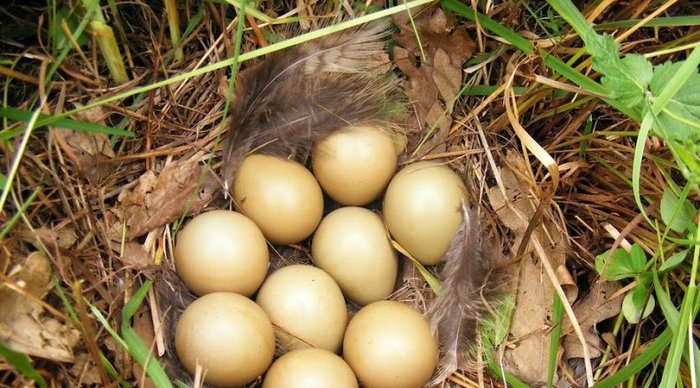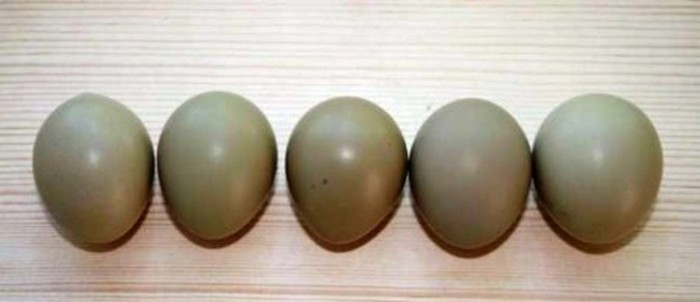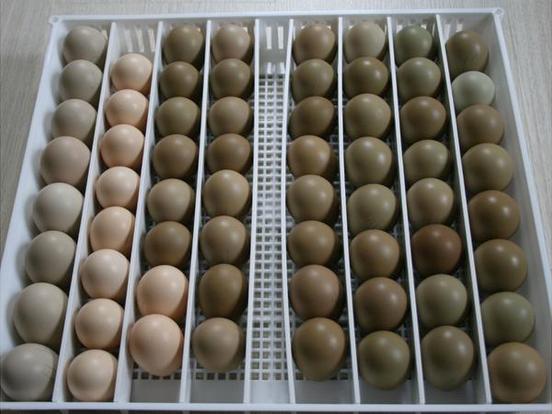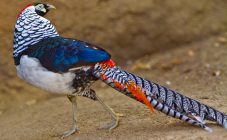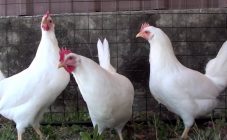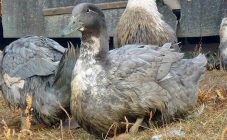Content:
These amazing birds are characterized by high egg production, memorable appearance, proud body. Their eggs are also considered unique. They are in demand by connoisseurs and are expensive. Their benefits are invaluable. Pheasant eggs are not obtained on all farms, since this is a difficult process, which will be discussed in the article.
Description of pheasant eggs
A pheasant egg is half the size of a chicken egg. The average weight is about 30 g. The size depends on the breed and living conditions of the pheasant. In the Caucasian territory, they are larger than in other regions. Females there lay eggs of light and dark shades of brown.
In general, colors can be varied: from gray to dark green. There are brown and variegated, which is due to the color of the bird. Eggs can be solid or speckled.
The shell is very fragile and has small pores. One testicle contains many useful and nutritious substances, vitamins, minerals. They are used both in cooking and in cosmetology and pharmacology. So, 100 g contains:
- protein - 6.5 g;
- carbohydrates - 4.3 g;
- water - 1.5 g;
- ash - 1.3 g;
- fat - 70.7 g;
- vitamin A;
- B vitamins;
- vitamin D;
- iron;
- magnesium;
- calcium;
- fluorine;
- zinc:
- selenium;
- copper.
The yolk is larger than chicken. Boiled protein tastes much more tender. They should not be consumed by obese people who are overweight. But they are very useful for heavy physical exertion, depletion of the body. Eating pheasant eggs can provide a person with a protein that is not found in any other egg product. Some breeds lay eggs that taste different from others. Other layers carry such that they are almost indistinguishable from domestic chicken.
Female pheasants begin to lay 2 weeks after the mating season. How many eggs a pheasant lays a year depends on the conditions of feeding. On average, the female lays 1-2 eggs per day.
Females hatch eggs from April to August. They have a bad memory, they do not remember their cubs, they make many nests as a poet. How many female pheasants sit on eggs? The average time is 25 days.
Eggs suitable for incubation
Rigorous selection before hatching is the main condition for getting good young.
Laying hens can rarely carry themselves. Typically, an incubator is used. Eggs must be carefully checked before being sent to the machine. This is done using a special ovoscope device. It detects any deviations. What determines:
- shell quality;
- protein composition;
- location of the yolk and its color;
- the size of the air chamber.
Testicles come in three categories: medium, small, and large. For good young animals, large sizes are taken. The ideal weight is 55-75 g. If small, elongated eggs with thin shells are laid, the embryos may die or become retarded. Eggs with the following defects must not be placed in the incubator:
- two yolks;
- damaged shell;
- blood stains;
- enlarged pores.
The shell should be flat and smooth. Eggs with dents, concavities or ridges are not allowed. Cracks are also not acceptable. If there are green, pink or gray spots, they decompose. Also, dirty ones will not work, and they cannot be washed, since the upper protective invisible layer will be destroyed.
The yolk should have a uniform structure, centered. Check this way: slightly turn the egg, if the yolk comes back, the fruit is selected correctly.
Egg storage rules before incubation
To achieve an excellent result, eggs must be kept in optimal conditions for 7 days. During this time, you can accumulate a lot, and then lay down everything at the same time. At the end of the ripening period, many chicks will hatch.
It is recommended to store eggs in a well-ventilated area at a temperature of 10 ° C. It is worth considering that the shell is very thin and absorbs all odors. Drafts or sudden temperature changes are not allowed, as condensation may form, which will provoke the appearance of microbes and bacteria.
If they have been transported for a long time, they need rest. After 10 hours, they are laid out horizontally on trays. They must be turned over at least 2 times in 1 day.
Immediately before placing in the incubation equipment, the eggs should be warmed up to room temperature. You can do this with a mercury-quartz lamp, placing them for 30 minutes. under it or put in warm water for 1-2 hours.
Switch on the equipment 24 hours before putting it into test mode. This will check its functioning, performance and create the desired microclimate.
Incubation period
7 days before incubation, eggs are cleaned and treated with formaldehyde solution.
Incubation of pheasant eggs is carried out in the first 3 days at a temperature of 38.5 ° C, then reduced to 37.5 ° C. Humidity should be 65%.
How many days does the incubation of pheasants take? The process will take 23-25 days.
The final hatching of pheasants in the incubator takes 1-6 hours. When they hatch into the light, they are left warm to dry out.
The main mistakes when breeding pheasants
List of common incubation oversights:
- The high heating temperature provokes the early appearance of chicks. Internal organs are not sufficiently formed.
- Insufficient heating. In this case, the young are hatched later than the due date and obvious deviations are observed in development.
- Low humidity levels cause emaciation and weakness in birds. Also, the chick can stick to the shell and not hatch at all.
- High humidity will be harmful: it will slow down or stop the development of the embryo.
Pheasants are hardy birds, but breeding their offspring is not as easy as it seems at first glance. In this process, it is important to adhere to certain rules and recommendations from experienced breeders. And even the appearance of the long-awaited chicks is not a reason to relax, since then there is a long and painstaking care for the young. Considering all the nuances, a breeder, even a beginner, will definitely succeed.
